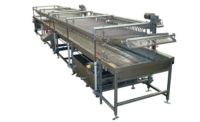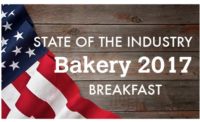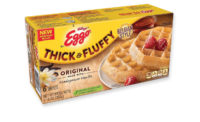The flexibility to produce different flavors, shapes, sizes and types of products is high on the list of qualities that snack and bakery makers are seeking from manufacturers offering griddle equipment and fryers.
Sweet goods solutions
Moline Machinery, Duluth, MN, has been fielding requests for different custom shapes for its doughnuts, fritters and other fried, sweet goods, says David Moline, sales and marketing manager. In order to meet this varied demand, the company offers equipment that can handle a wide range of product options. “We can sell you a doughnut fryer that can do pretty much everything,” he says, “from large, raised yeast rings, to mini doughnuts, to mini doughnut holes, all on the same machine.”
The Moline LIBRA Dual Fuel Fryer combines efficient electric heating elements with the economic advantage of natural gas burners. The system offers stable temperature control across the width of the kettle to improve product quality.
Moline says that handling different-sized products is typically the largest challenge in doughnut frying, because the surface needs to be designed with larger products in mind, which means the smaller ones “tend to want to drift around,” he says. But Moline Machinery has designed its doughnut fryers to effectively control this tendency, which in turn keeps oil currents to a minimum and oil quality higher for a longer stretch, he says.
WP Bakery Group USA has concentrated efforts on improving the energy efficiency of its WP Riehle kettle fryers, achieved through a digital thermostat that controls temperature within one degree when doughnuts are lowered into the basket, as well as electric rather than gas heating. That’s a bit more expensive on the front end but more efficient—and thus cheaper—in the long run, notes Bruce Gingrich, vice president, sales.
The WP Riehle LINIE 2000A open kettle fryer offers 10 frying programs, each with four potential individual frying times. Other features include:
- An auto steam lid to help increase doughnut volume
- Digital pulse heating for precise temperature control minimizes temperature fluctuations and oil consumption Manual or automatic mode
- An automatic basket lift at end of fry cycle
- Oil monitoring to track hours of oil use to aid in oil management
The WP Riehle DLA Continuous Open kettle fryer enables a continuous frying process and consistent frying results. The transport conveyor with submerging belt submerges the products, guides the products through the fryer and transports them out automatically at the end. This submerging process contributes to shorten the frying up to 40 percent, using less oil, less energy and less labor.
WP Bakery Group also offers a wide variety of custom solutions where some competitors do not, Gingrich says. “A lot of fryers say, ‘Here’s our solution for this, here’s our solution for that,’ but they’re all cookie-cutter,” he says. “We design specific to your application.”
Streamlining breakfast
The market for frozen breakfast items like pancakes and waffles is also growing more diversified. Hinds-Bock, Bothell, WA, has been seeing a greater demand for equipment that can produce varying sizes of pancakes and waffles, says Mark Young, senior sales executive. “It’s so they can run multiple SKUs during a shift, rather than dedicating the equipment to just one SKU,” he says. “We’re noticing that not just from the co-packing or private label side, but also traditional waffle and pancake manufacturing entities. That’s just a direct reflection on the economy, not knowing the longevity of a product line, but being able to tool-up and scale-up.”
Young also has noticed more producers looking for clean-in-place (CIP) solutions, in part to be able to reduce labor costs as state and local governments raise their minimum wages. “In Washington State, it’s going to be $15 per hour,” he says. “To avoid having to pay a guy to stand there with a spray gun all night—it’s going to affect how the equipment is going to be spec’d out.”
Hinds-Bock has been improving the ability of its equipment to dispense batter with extremely high degrees of accuracy over everything from clamshell griddles to griddle-plate ovens, Young says. “We’ve been doing that over existing oven lines,” he says.
AMF Bakery Systems, Richmond, VA, also has seen demand for greater product variety and system flexibility when it comes to breakfast, says Diana Burke, global marketing manager.
In partnership with Sugden Ltd., AMF Bakery Systems offers English muffin system production lines that can handle 6,000 to 26,000 units per hour, notes Burke. “The fully insulated griddle with super burners reduces energy consumption by up to 20 percent,” she says. “Quick changeover of muffin cap plates allows for varying product specifications and sizes with maximum flexibility in proofer and griddle layout.”
Fryer efficiency
The Florigo vacuum fryers from tna Solutions have experienced greater demand from midsized companies instead of just traditional, larger firms, says Arnaud Jansse, applications engineer, Florigo Industry B.V., Woerden, the Netherlands, a tna company. About a half-dozen such companies approached tna last year, and another half-dozen have come forward this year with requests for healthy, natural vegetable chips, he says.
“Of course, it means that the market on the consumer side is getting aware of vegetable chips, and they like it,” says Jansse. “Middle-sized companies are getting ready to invest in a vacuum system.”
With the launch of its new Florigo Conti-Pro 3 fryer, tna also has been working to control the flow of all types of chips and shorten dwell time so they absorb less oil, thanks to the company’s patented Opti-Flow technology, Jansse adds. “We give a little bit more control on oil absorption,” he says. “Also, by controlling the flow, we make sure that every single chip has more or less the same dwell time.” This translates into fewer rejects, more yield and higher quality.
Other features of the Florigo Conti-Pro include a product transport system with spring steel sealing, an easy-to-navigate touchscreen operating system and an insulated hood with a condensation-collecting pan that can be automatically lifted. The new fryer comes is fitted with an internal CIP system with hidden pipes in the hood to further ease cleaning and maintenance.
Different conveying, frying and seasoning systems from PPM Technologies, Newberg, OR, bring more flexibility to snack producers. “We’re seeing major operations partnering with co-packers to get this done and enable them to be more nimble,” says Nathan Lee, vice president of sales, U.S. and Canada. “Related to that, we’re seeing an uptick in requests for seasoning systems that can handle consumer demands for multiple types of product flavors.”
PPM has released an all-in-one, turnkey unit that comes equipped with a drum that’s easy to slide in and out, and which has an adjustable dwell time, Lee says. “You change the angle of the drum, and you can hold the product longer, or have it cycle through faster, depending on what you need to do,” he says.
Designed with “lightning-fast changeovers” in mind, the system opens from the front and bottom to let the operator reclaim seasonings, which also provides easy access for cleaning and maintenance, Lee says. “You can go from mild to wild,” he says.
Building a better frying oil
Dow AgroSciences, Indianapolis, IN, works with manufacturers to produce high-quality frying oil. This means producing oil that stays clean, lasts as long as possible and doesn’t “gunk” equipment, says Dave Booher, group leader, healthy oils.
“The hotter the exposure, the tougher it is on the oil and the faster it breaks down,” Booher says. “If it’s high in polyunsaturated fats, and it breaks down, the nice term is ‘gunking’ of equipment. On a griddle application, you get excessive blackening, which can cause cleaning issues. Depending on the type of fryer, we’ve seen polymer compounds build up on heat exchangers, which causes less efficiency as a result.”
High-stability products like Omega-9 canola oil, which has a high level of monounsaturated fat, cause less gunking, notes Booher. “Typically, oils with high stability have better performance criteria,” he says. “Saturated fat is very stable, but it’s not what we’re looking for from a health profile.” He notes that polyunsaturated fats don’t last as long in the fryer, with some issues like development of off-flavors and off-colors.
The Omega-9 oil provides the “best of both worlds,” Booher says. “It has a great nutritional profile and low levels of saturated fat,” he says. “It requires less labor, because typically the oil is going to last longer.” Depending on the type of fryer and application, he says, Omega-9 oils offer “significant savings from the longer turnover and the ability to use the same batch of oil.”










